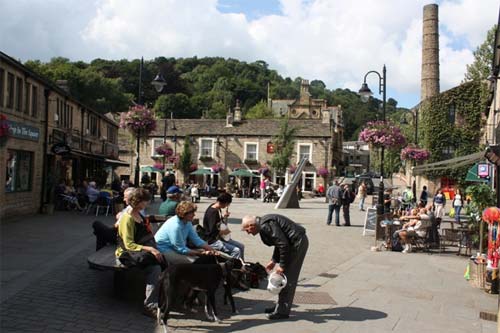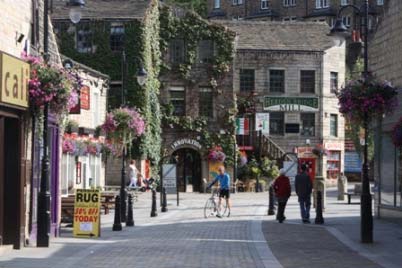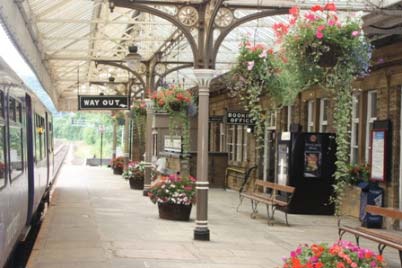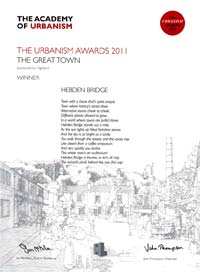Ian McMillan writes poem about Hebden Bridge which is declared "Great Town"
Saturday, 20 November 2010
 Yesterday afternoon, Hebden Bridge won the 'Great Town Award' given by The Academy of Urbanism. Previously, Hebden Bridge has been voted the 4th funkiest town in the world and the UK town with most local identity.
Yesterday afternoon, Hebden Bridge won the 'Great Town Award' given by The Academy of Urbanism. Previously, Hebden Bridge has been voted the 4th funkiest town in the world and the UK town with most local identity.
Ian McMillan (pictured right in Hebden Bridge), who is Poet-in-Residence at the Academy of Urbanism, wrote the poem below which captures the spirit of our town.
HEBDEN BRIDGE
Town with a tissue that's quite unique;
Town where history's strata show
Alternative visions cheek to cheek,
Different plants allowed to grow.
In a world where towns are pallid clones
Hebden Bridge stands out a mile,
As the sun lights up West Yorkshire stones
And the sky is as bright as a smile;
You walk through the street and the voices rise
Like steam from a coffee emporium
And very quickly you realise
The whole town's an auditorium!
Hebden Bridge is theatre, so let's all clap
The wizard's cloak behind the new flat cap!
Ian McMillan
The Academy of Urbanism has written the following about Hebden Bridge
Hebden Bridge has a population of around 4,500 and is the smallest of the candidates in this category. Situated within the Metropolitan Borough of Calderdale in West Yorkshire, it forms part of the Upper Calder Valley and lies eight miles west of Halifax and 14 miles north east of Rochdale,at the confluence of the River Calder and the River Hebden (Hebden Water). A 2004 profile of the Calder Valley ward, covering Hebden Bridge, Old Town, and part of Todmorden, estimated the wider population at 11,549.

The original settlement was the hilltop village of Heptonstall. Hebden Bridge started as a settlement where the Halifax to Burnley hilltop packhorse route dropped down into the valley. The route crossed the River Hebden at the spot where the old bridge (from where Hebden Bridge gets its name) stands.
The steep wet hills and access to major wool markets meant that Hebden Bridge was ideal for water powered weaving mills and the town developed during the 19th and 20th centuries; at one time Hebden was so well-known for its clothing manufacture that it was known as 'Trouser Town'. Drainage of the marshland which covered much of the Upper Calder Valley prior to the Industrial Revolution enabled construction of the road which runs through the valley. Prior to this, travel was only possible via the ancient packhorse route which ran along the hilltop, dropping into the valleys wherever necessary, as was the case with Hebden Bridge. The wool trade also brought the Rochdale and the Manchester and Leeds Railway running from Leeds to Manchester and Burnley.

Hebden Bridge was the second town that the asse ssment team visited and it too set a high standard. As in Stroud, the relationship between the landscape and the town is remarkably integrated and first impressions on arriving at the railway station demonstrate the often dramatic nature of the bond between town structure and landscape. Walking from the station to the town centre along main roads was a less pleasant experience - the A646 is a busy route through the town and footpaths are quite narrow. However, once in the centre of the town, the pedestrian scale, high quality finishes of the public realm, and the standard of care were excellent. Even in the centre, the impact of the surrounding landscape is strong - and there is no unsympathetic development to undermine the natural setting of the town.
The standards of maintenance of streets, footpaths and buildings was very high as was the quality and extent of landscaping, especially the floral displays and hanging baskets.
Heritage plays a major role in Hebden Bridge and there is a marked interest and pride in the historical development of the town that informs how the town reacts to 21st century aspirations and pressures. This also plays out in the range of heritage trails as well as attitudestonewbuilding. Forexample,thetownisintentonbuildinganextensiontothetown hall that will provide community rooms and business together with new public space along the riverside. This has been developed over a considerable period of time with community involvement (through the Friends of the Town Hall) and has resulted in a proposal for a new building which is contemporary yet contextual, that everyone seems happy with.

Alternative energy is also a major interest in Hebden Bridge focused on an Alternative T echnology Centre beside the canal. The Centre organises various initiatives including Big Green Week and a Power From The Landscape project, which seeks to support communities in the development of micro hydro-electric schemes using the same sources of water power that originally powered the town industries in the 19th century.
Linear greenspace plays an important part in the town through footpaths and cycleways along the canal, through the town centre along the Hebden Water and along the River Calder. These paths are well signposted and trail leaflets are available to guide the visitor through the town.
Like Stroud, Hebden Bridge seems to be the very embodiment of the current government's aspirations to the Big Society and like Stroud, Hebden Bridge was doing the Big Society many years before the term's current usage. The town's community organisations have recognised the assets of place - physical, social and economic - and have worked hard to make the most of these with the local authorities and Yorkshire Forward. Again like Stroud, it seemed to the assessment team that this was a town in which it was possible for individuals in the community to originate ideas and proposals for projects that would benefit the town and find a way to implement them. There seemed to be a genuine pride of place and a shared interest in getting things done.
There are many notable achievements in Hebden Bridge but one of the most obvious in terms of the built environment is howrelatively intact it seems. Certainly buildings have come and gone over the years but there is a sense that what is there has an integrity, completeness and appropriateness - and it is also well looked after.
At the same time, there are some issues which present the town with some difficulties. The lack of developable land due to the local topography, which in some ways can be seen as a blessing,could inhibit the future growth of the town. Even land for allotments is almost impossible to find short of terracing the slopes of the surrounding hillsides. The impact of traffic along the A646 makes for an uncomfortable pedestrian experience and it would be constructive to look at ways of ameliorating that.
The transferable lessons of excellence that can be learned by others from Hebden Bridge are:
A. the sense of ownership of the town, civic pride and community management and the willingness of local authorities to adapt to and support a wide range of small scale community projects, in this case focusing around heritage and alternative technology but also covering a wide range of local interests
B.the principle of working with smallscale ideas and the fine grain of local areas - not only in the sense of physical fabric but also the grain of the community
C. potentially, how the knowledge and experience gained in this work is passed on to others over a wider area - and how new generations can acquire this knowledge and ability so that it does not disappear when particular individuals move on.
The above is from the Academy of Urbanism
See also:
4th funkiest town in the world
The UK town with most local identity.



